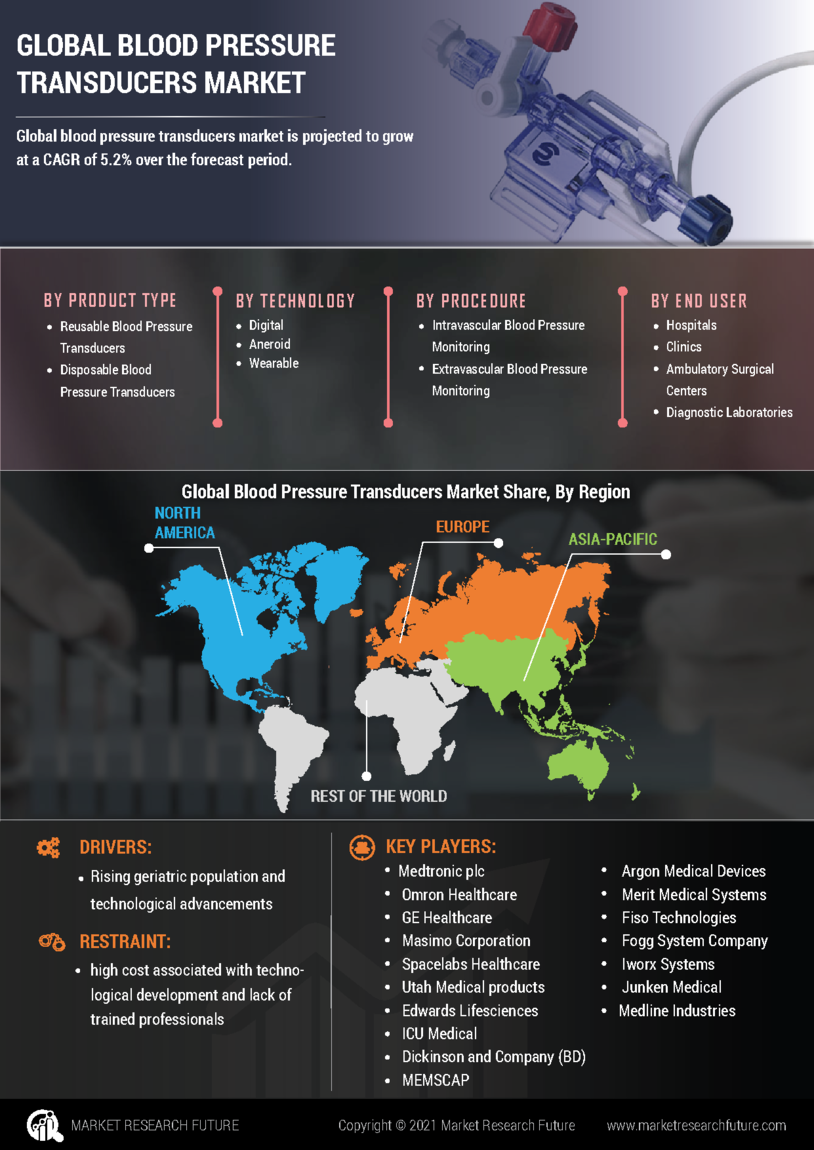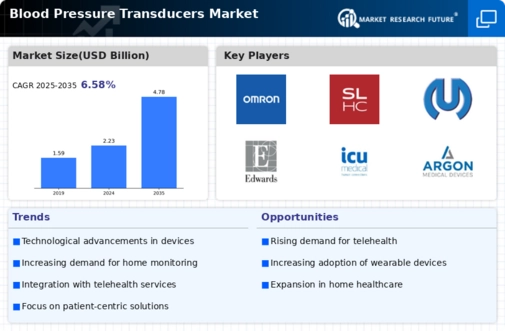Market Growth Projections
The Global Blood Pressure Transducers Market Industry is projected to experience substantial growth in the coming years. With an estimated market value of 2.23 USD Billion in 2024, it is anticipated to reach 4.78 USD Billion by 2035. This growth trajectory reflects a compound annual growth rate of 7.18% from 2025 to 2035, driven by various factors including technological advancements, increasing healthcare expenditure, and a growing emphasis on preventive healthcare. The market dynamics suggest a robust expansion, indicating that blood pressure transducers will play an increasingly vital role in hypertension management globally.
Increasing Geriatric Population
The global increase in the geriatric population is a crucial driver for the Global Blood Pressure Transducers Market Industry. Older adults are more susceptible to hypertension and related cardiovascular diseases, necessitating regular blood pressure monitoring. By 2035, the global population aged 60 years and older is projected to reach 1.4 billion, creating a substantial demand for effective monitoring solutions. Healthcare systems are adapting to this demographic shift by investing in advanced blood pressure transducers that cater specifically to the needs of elderly patients. This trend underscores the importance of reliable monitoring devices in managing chronic conditions prevalent among older adults.
Regulatory Support and Standards
Regulatory support and the establishment of standards for blood pressure monitoring devices play a pivotal role in shaping the Global Blood Pressure Transducers Market Industry. Governments and health organizations are implementing stringent regulations to ensure the safety and efficacy of medical devices. This regulatory framework not only fosters innovation but also instills confidence among healthcare providers and patients regarding the reliability of blood pressure transducers. As manufacturers comply with these standards, the market is likely to experience increased acceptance and utilization of advanced monitoring technologies. This regulatory environment is essential for sustaining growth in the industry.
Rising Prevalence of Hypertension
The increasing prevalence of hypertension globally drives the Global Blood Pressure Transducers Market Industry. As per recent health statistics, approximately 1.13 billion people worldwide are living with hypertension, which necessitates regular monitoring. This growing patient population is likely to boost demand for blood pressure transducers, which are essential for accurate and timely blood pressure measurements. The market is projected to reach 2.23 USD Billion in 2024, reflecting the urgent need for effective management of hypertension. Healthcare providers are increasingly adopting advanced transducer technologies to enhance patient outcomes, thereby propelling market growth.
Growing Awareness of Preventive Healthcare
The rising awareness of preventive healthcare practices is influencing the Global Blood Pressure Transducers Market Industry positively. Public health campaigns and educational initiatives are increasingly emphasizing the importance of regular blood pressure monitoring to prevent complications associated with hypertension. This heightened awareness is likely to lead to greater adoption of blood pressure transducers in both clinical and home settings. As individuals become more proactive about their health, the demand for user-friendly and accurate monitoring devices is expected to surge. Consequently, the market is poised for growth, aligning with the global shift towards preventive healthcare strategies.
Technological Advancements in Monitoring Devices
Technological advancements in blood pressure monitoring devices significantly contribute to the expansion of the Global Blood Pressure Transducers Market Industry. Innovations such as wireless connectivity, miniaturization, and enhanced accuracy are transforming traditional monitoring methods. For instance, the integration of digital technologies allows for real-time data transmission to healthcare providers, facilitating timely interventions. These advancements not only improve patient compliance but also enhance the overall efficiency of hypertension management. As a result, the market is expected to witness a compound annual growth rate of 7.18% from 2025 to 2035, indicating a robust growth trajectory driven by technology.

















Leave a Comment